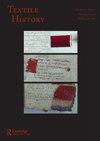穿着“仿佛是为了狂欢节”:解开儿童时尚起源之谜。童装历史与史学的新视角
IF 0.1
2区 社会学
0 HUMANITIES, MULTIDISCIPLINARY
引用次数: 1
摘要
这篇文章有两个重点:解释18世纪末儿童时尚迄今为止不为人知的起源,并将其出现置于这一关键时期“发现童年”的“大叙事”背景下。与卢梭著名的对轻骑兵套装的否定相反,“奇装异服”灵感在儿童时尚发展中的作用首次有目的地将(男性)儿童与成年人区分开来,与启蒙运动关于儿童的思想同时,成为中心而非边缘。男孩服装所采用的风格系列被证明受到了各种种族和历史服饰传统的启发,这些传统植根于对洛可可文化伪装特征的迷恋,但却被用来表达新兴的新态度。其中,特别注重波兰民族服饰的灵感。其次,本文采用了丹尼尔·托马斯·库克在《纺织史》第42期第1期(2011年)上发表的一篇鼓舞人心的文章中提出的论点。库克承认时尚史在儿童研究出现中的基础性作用,认为其目前的地位是次要的。他驳斥了其主要“宏大叙事”的基本前提,认为其基于实用性(和功能性)和时尚之间的徒劳区分,而不是“儿童”和“童年”的发明或发现。虽然部分接受了库克的批评,但文章认为,经过修改和扩展的“宏大叙事”仍然有用。在19世纪,“花哨的衣服”和“嬉戏”的主题继续存在,反映在最流行的儿童风格(水手服、小领主福特勒罗伊服)和一系列其他风格中,暂时或局部突出,并与各种文化、艺术、社会和商业发展交织在一起。本文章由计算机程序翻译,如有差异,请以英文原文为准。
Dressed ‘as if for a Carnival’: Solving the Mystery of the Origins of Children’s Fashion. A New Perspective on the History and Historiography of Children’s Dress
The article has a double focus: explaining the so-far obscure origins of children’s fashion in the later eighteenth century and putting its emergence in the context of the ‘grand narrative’ concerning the ‘discovery of childhood’ during this pivotal period. Contrary to Rousseau’s famous dismissal of the hussar suit, the role of ‘fancy dress’ inspiration in the development of children’s fashions for the first time purposefully meant to distinguish the (male) child from the grown-ups and, concurrent with the Enlightenment’s ideas on childhood, emerges as central rather than marginal. The repertory of styles adopted for boys’ wear is shown to have been inspired by various ethnic and historical dress traditions rooted in the fascination with masquerade characteristic of the Rococo culture but harnessed to express the emerging new attitudes. Among them, special attention is given to inspirations by Polish national dress. Second, the article takes on the argument presented by Daniel Thomas Cook in his inspiring article in Textile History, 42, no. 1 (2011). Having acknowledged the foundational role of fashion history in the emergence of childhood studies, Cook regards its present status as peripheral. He dismisses the underlying premise of its principal ‘grand narrative’ as based on a fruitless distinction between utility (and functionality) and fashion rather than the invention or discovery of the ‘child’ and ‘childhood’. While partially accepting Cook’s criticism, the article argues that the ‘grand narrative’, thus modified and expanded, retains its usefulness. In the nineteenth century, the ‘fancy dress’ and ‘playfulness’ theme continued, reflected in the most popular children’s styles (sailor suit, Little Lord Fauntleroy suit) and a range of others, temporarily or locally prominent, and intertwining with multifarious cultural, artistic, social and commercial developments.
求助全文
通过发布文献求助,成功后即可免费获取论文全文。
去求助
来源期刊

TEXTILE HISTORY
HUMANITIES, MULTIDISCIPLINARY-
CiteScore
1.00
自引率
0.00%
发文量
0
期刊介绍:
Textile History is an internationally recognised, peer reviewed journal and one of the leading publications in its field. It is viewed as an important outlet for current research. Published in the spring and autumn of each year, its remit has always been to facilitate the publication of high-quality research and discussion in all aspects of scholarship arising from the history of textiles and dress. Since its foundation the scope of the journal has been substantially expanded to include articles dealing with aspects of the cultural and social history of apparel and textiles, as well as issues arising from the exhibition, preservation and interpretation of historic textiles or clothing.
 求助内容:
求助内容: 应助结果提醒方式:
应助结果提醒方式:


